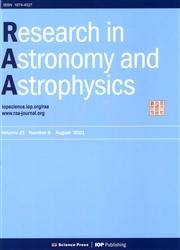对近日点距离较大的彗星C/2019 L3(ATLAS)和C/2019 O3(Palomar)的研究
IF 2.8
4区 物理与天体物理
Q3 ASTRONOMY & ASTROPHYSICS
引用次数: 0
摘要
这项工作分析了 ATLAS 网络和比利时奥尔门天文台在 2016 年至 2023 年期间获得的奥尔特尖顶彗星 C/2019 L3(ATLAS)和 C/2019 O3(Palomar)的测光数据。根据在近日点校正为相角零的 Afρ 参数,Palomar 和 ATLAS 彗星分别具有典型和异常高的活动水平。ATLAS 和 Palomar 彗星在 o 波段的绝对星等分别为 4.71 ± 0.05 和 4.16 ± 0.02。ATLAS 和 Palomar 彗星的彗星活动可能始于近日点前 r > 13 au 处,将在近日点后 r > 14 au 处结束,这意味着它们的活动可能持续到 2026 年下半年。ATLAS 彗星的彗核半径最小为 7.9 千米,帕洛玛彗星的彗核可能稍大一些。与太阳孪生彗星YBP 1194相比,ATLAS彗星和Palomar彗星在近日点的c-o颜色分别更红和更蓝。随着日心距离的减小,这些彗星的彗尾颜色呈现出偏蓝的趋势。帕洛玛彗星在近日点之后可能发生过两次爆发,每次都释放出大约 108 千克的尘埃。这些彗星的彗尾光度曲线的斜率在 1 和 1.5 之间,表明在观测活动期间处于稳定状态。本文章由计算机程序翻译,如有差异,请以英文原文为准。
A Study of the Comets with Large Perihelion Distances C/2019 L3 (ATLAS) and C/2019 O3 (Palomar)
This work analyzes the photometric data of the Oort spike comets C/2019 L3 (ATLAS) and C/2019 O3 (Palomar) obtained between 2016 and 2023 by the ATLAS network and the Belgian Olmen Observatory. The comets Palomar and ATLAS have a typical and unusually high activity level, respectively, based on the Afρ parameter corrected to phase angle zero at perihelion. The absolute magnitude of comets ATLAS and Palomar in the o-band is 4.71 ± 0.05 and 4.16 ± 0.02 respectively. The cometary activity of comets ATLAS and Palomar probably began at r > 13 au before perihelion and will end at r >14 au after perihelion, which means that they could remain active until the second half of 2026. The nucleus of comet ATLAS has a minimum radius of 7.9 km, and the nucleus of comet Palomar could be a little larger. The c − o colors of the comets ATLAS and Palomar are redder and bluer, respectively, at perihelion than the solar twin YBP 1194. These comets showed a bluish trend in the coma color with decreasing heliocentric distance. Comet Palomar probably had two outbursts after its perihelion, each releasing about 108 kg of dust. The slopes of the photometric profile of the comae of these comets were between 1 and 1.5, indicating a steady state during the observation campaign.
求助全文
通过发布文献求助,成功后即可免费获取论文全文。
去求助
来源期刊

Research in Astronomy and Astrophysics
地学天文-天文与天体物理
CiteScore
3.20
自引率
16.70%
发文量
2599
审稿时长
6.0 months
期刊介绍:
Research in Astronomy and Astrophysics (RAA) is an international journal publishing original research papers and reviews across all branches of astronomy and astrophysics, with a particular interest in the following topics:
-large-scale structure of universe formation and evolution of galaxies-
high-energy and cataclysmic processes in astrophysics-
formation and evolution of stars-
astrogeodynamics-
solar magnetic activity and heliogeospace environments-
dynamics of celestial bodies in the solar system and artificial bodies-
space observation and exploration-
new astronomical techniques and methods
 求助内容:
求助内容: 应助结果提醒方式:
应助结果提醒方式:


